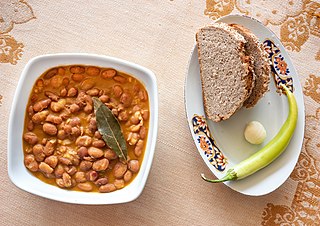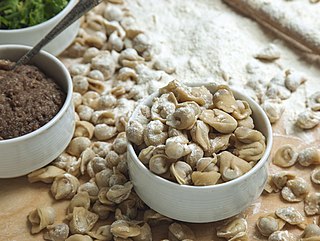Related Research Articles

Khash is a dish of boiled cow or sheep parts, which might include the head, feet, and stomach (tripe). It is a dish of Armenian origin.

Kofta is a family of meatball or meatloaf dishes found in Balkan, Middle Eastern, North African, South Caucasian, South Asian and Central Asian cuisines. In the simplest form, koftas consist of balls of minced meat – usually beef, chicken, pork, lamb or mutton, or a mixture – mixed with spices and sometimes other ingredients. The earliest known recipes are found in early Arab cookbooks and call for ground lamb.

Mykyrokka is a soup that is a typical traditional dish in eastern Finland. The main ingredient is myky: a palm sized dumpling made from blood and barley flour. The dumplings are cooked in the soup. The soup also contains potatoes, onions, fatty meat, and offal such as kidneys, liver and or heart. Salt and black pepper are the usual seasonings.

Abgoosht is an Iranian stew. It is also called dizi, which refers to the traditional stoneware crocks it is served in. Some describe it as a "hearty mutton Persian soup thickened with chickpeas."

Blood soup is any soup that uses blood as a principal ingredient.
Azerbaijani cuisine refers to the cooking styles and dishes of the Republic of Azerbaijan. The cuisine is influenced by the country's diversity of agriculture, from abundant grasslands which historically allowed for a culture of pastoralism to develop, as well as to the unique geographical location of Azerbaijan, which is situated on the crossroads of Europe and Asia with an access to the Caspian Sea. The location has enabled the people to develop a varied diet rich in produce, milk products, and meat, including beef, mutton, fish and game. The location, which was contended over by many historical kingdoms, khanates, and empires, also meant that Azerbaijani cuisine was influenced by the culinary traditions of multiple different cultures, such as Turkic, Iranian, and Eastern European.

Pasulj, grah (грах) or grav (грав) is a bean stew made of usually white, cranberry or pinto beans, and more rarely kidney beans that is a popular dish in Balkan cuisine. It is normally prepared with meat, particularly smoked meat such as smoked bacon, sausage, and ham hock, and is a typical winter dish. Other commonly used ingredients include carrots and onions. Another version of the dish using baked beans is known as prebranac (пребранац).

Tharid is a bread soup from Arab cuisine found in many Arab countries. Like other bread soups, it a simple meal of broth and bread in this instance crumbled flatbread moistened with broth or stew. Historically, the flatbread used was probably stale and unleavened. As an Arab national dish it is considered strongly evocative of Arab identity during the lifetime of the Islamic prophet Muhammad. According to a widespread legend, this unremarkable and humble dish was the prophet's favorite food.

Nam tok is either a soup or a meat salad from Southeast Asia. In the Lao and Thai language, the phrase means waterfall. The meat salad in Lao cuisine is a sliced beef steak instead of minced meat version of larb, Laos' national dish.

Dovga is a soup made from plain yoghurt and herbs and is a staple of Azerbaijani cuisine. Traditionally, it is served as a wedding soup and is introduced between courses of meat, intended to boost digestion.

Toyga is a national meal of Turkish cuisine. It is a yogurt soup cooked with a variety of herbs, wheat and (sometimes) chickpeas.

Ash-e doogh is a yogurt soup found in various parts of Iran, Azerbaijan and Shiraz, with differing but similar ingredients. It is a kind of Aush. Similar dishes are found all over West Asia.

Bozbash is an Iranian dish consisting of meat stew popular in Armenia, Azerbaijan and Iran.

Joshpara is a kind of dumpling popular in Central Asia, South Caucasus and the Middle East. They are made of unleavened wheat dough squares filled with ground meat and condiments. In observance of the Islamic dietary rules, the meat filling is usually without pork.